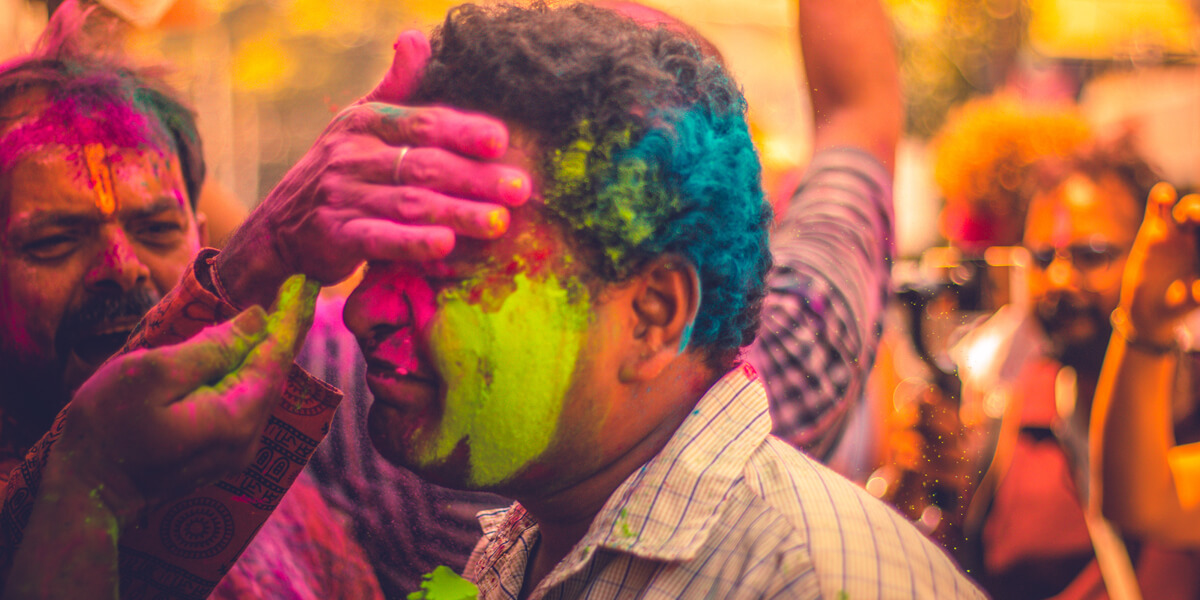Festival of Colour: The Story of Holi

Holi, AKA the Festival of Colour, symbolises the start of spring and is a festival of love. A Hindu festival originating in India, it’s since spread to Nepal and western countries.
Holi is a time for family to get together, eat, drink, dance, play music and paint each other with coloured powder and water.
There are several origins of the Festival of Colours but two of the biggest are the Vishnu legend and the Krishna legend.
Vishnu Legend
King Hiranyakashipu was king of the demonic Asuras – a class of divine beings and power-seeking deities. He’s earned a blessing which gave him five special powers.
He could be killed...
- by neither human nor animal,
- neither indoors nor outdoors,
- neither during day nor night,
- neither by projective weapon nor handheld weapon,
- neither on land nor in water or air.

King Hiranyakashipu quickly became arrogant and thought he was God. He demanded that everyone worship only him and thought he was all powerful.
But one person refused to worship him. Hiranyakashipu’s own son, Prahlada, refused to worship him and remained devoted to Vishnu. This incensed Hiranyakashipu and he subjected his son to cruel punishments. But nothing stopped Prahlada from doing what was right.
In a final attempt, Hiranyakashipu enlisted the help of Prahlada’s evil aunt, Holika. Holika devised a plan to force Prahlada into worshipping his father.
Wrapped in a fire-proof cloak, Holika built a pyre and tricked Prahlada into sitting on it. As the flames grew larger and the fire roared around them, Holika’s cloak was whipped off her and settled around Prahlada protecting him from the fire while his wicked aunt burned.
Tired of his arrogance and egotism, Vishnu took the form of Narasimha a half human, half man at dusk (neither day nor night) and took Hiranyakashipu from a doorstep (neither indoors nor outdoors), placed him on his lap (neither land, water or air), and then tore him apart with his lion claws (neither a handheld nor launch weapon).
Holi represents the triumph of Prahlada over Hiranyakashipu, of good over evil. Holika Dahan represents the bonfire that destroyed Holika and so begins the Holi festivities.
Krishna Legend
In the Braj region of India where Krishna grew up, the festival is celebrated in commemoration of the divine love of Radha for Krishna. It signifies the end of winter and ushers in the start of spring, it symbolises new beginnings and is primarily a festival of love. All because of the love story between Radha and Krishna.
Krishna developed his iconic blue skin colour as a baby when the she-demon Putana tried to poison him with her breast milk.
As a self-conscious youth, Krishna was worried that girls wouldn’t like him because of his skin colour. But he was particularly concerned about the affections of the fair-skinned Radha.
Krishna’s mother quickly became fed up of his moping and his desperation. She decided that Krishna needed to level the playing field and so encouraged her son to approach Radha and colour her face any colour he wants.
One day, in a mischievous mood, Krishna remembered his mother’s advice and approached Radha armed with colour. He applied it to her face and from that moment on, the couple were one and the same and madly in love.
Ever since, Krishna’s playful colouring of Radha’s face has been commemorated as the Holi festival.

How it's celebrated
Holi is celebrated at the beginning of spring so there isn’t a fixed date.
It’s made up of two parts.
Holika Dahan
Holika Dahan is the lighting of bonfires to signify the fire that destroyed Holika and is a time for celebrating the victory of good over evil. The bonfires are held in parks, community centres, near temples and other open spaces.
Often, Holika is depicted as an effigy on top of the pyre ready to be burnt. The fire is typically lit at or after sunset and people gather to sing and dance.
Holi
Holi is celebrated the morning after Holika Dahan. Traditional prayer is cancelled and it’s a day purely for fun and celebration.
Adults and children alike go into the streets, dancing, singing and throwing powdered paint or coloured water at anybody and everybody. As a result, the day is called the Festival of Colours.
People visit their friends and family armed with coloured powder and traditional delicacies. Gujiya (a sweet deepfried dumpling), mathri (a flaky biscuit from north-western India), malpuas (a pancake) and bhang (an intoxicating cold drink).

Traditional colours
Traditionally, colours were made from natural ingredients like turmeric, beetroot and berries. But some colours are significant.
Red
Red is the colour of love, passion and fertility.
Blue
Blue symbolises Krishna as well as elements of nature like the sky and oceans.
Yellow
Yellow stands for knowledge, learning, happiness, meditation and peace.
Green
Like blue, green represents nature and signifies the start of spring and new beginnings.
Pink
Where red is the colour of love, pink is the colour of caring and compassion.
Purple
Finally, purple is the colour of magic and mystery.
So the next time you hear about the Festival of Colours, now you know what it’s all about!




